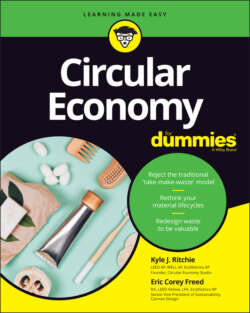Читать книгу Circular Economy For Dummies - Eric Corey Freed - Страница 34
Food production
ОглавлениеRedesigning the food production system to be circular will require shifting away from commercial strategies that are dependent on fossil fuels, pesticides, and artificial fertilizers to a more localized approach that relies instead on permaculture design strategies, developing polycultures rather than monocultures, and utilizing circular production strategies, like aquaponics. (For more detail on the circular economy and food production, see Chapter 15!)
The industrialized method of growing food is extremely wasteful in many ways. It requires the use of equipment that’s dependent on fossil fuels, high levels of harmful chemicals through the use of pesticides and fertilizers, and global shipping networks to deliver all these goods — not to mention the packaging required to preserve the produce. In addition, these methods create large amounts of food waste during the process because this system doesn’t support the recapture and reuse of unused or spoiled produce. Absolutely nothing about linear, industrialized food production supports the idea that waste is an unnecessary component of the food cycle.
By relying on a more localized approach to food production, many sources of industrialized wastes can be eliminated, such as transportation waste and food waste. Utilizing new methods of growing produce can also support the transition from a linear production to a circular one. Technologies such as indoor aquaponics allows for multiple ecosystems to flourish by utilizing the waste of one system to act as a resource for another. In such systems, fish waste acts as nutrients for the plants, and the plants then filter the water for the fish. Mimicking natural ecosystems is the only way we can redesign the food system to be circular.
The more a food production system mimics the natural world, the more efficient and effective it will be. You don’t see entire fields of single, row crops anywhere in nature. This fact alone is a major red flag.
